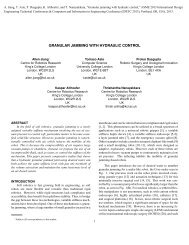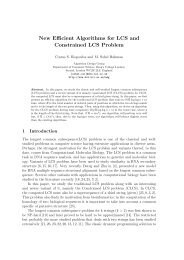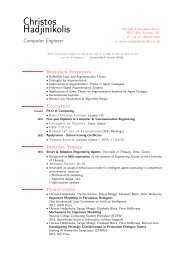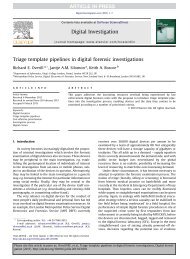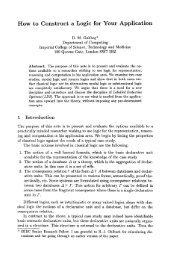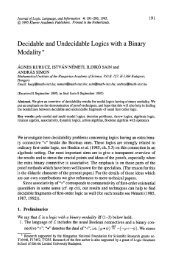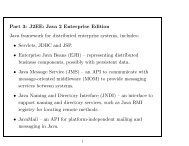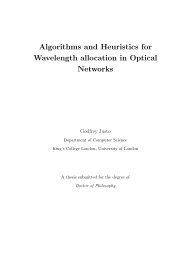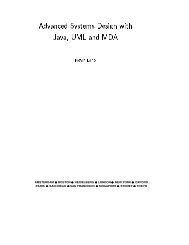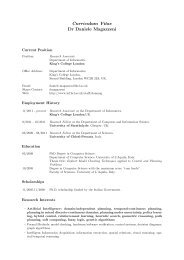slides - King's College London
slides - King's College London
slides - King's College London
Create successful ePaper yourself
Turn your PDF publications into a flip-book with our unique Google optimized e-Paper software.
Preliminaries<br />
Model and Problem Formulation<br />
Methods<br />
Experiments & Results<br />
Conclusions & Future Research<br />
Stochastic Local Search for the Optimization of<br />
Secondary Structure Packing in Proteins<br />
Leonidas Kapsokalivas Dr Kathleen Steinhöfel<br />
Computer Science Department<br />
King’s <strong>College</strong> <strong>London</strong><br />
LAW LSD 2010<br />
Leonidas Kapsokalivas, Dr Kathleen Steinhöfel LAW LSD 2010
Outline<br />
1 Preliminaries<br />
Background Work<br />
Motivation<br />
Preliminaries<br />
Model and Problem Formulation<br />
Methods<br />
Experiments & Results<br />
Conclusions & Future Research<br />
2 Model and Problem Formulation<br />
The off-Lattice Model<br />
Problem Formulation<br />
3 Methods<br />
The Move Set<br />
Monte Carlo-based Optimization<br />
4 Experiments & Results<br />
Benchmarks & Protocol<br />
Computational Results<br />
5 Conclusions & Future Research<br />
Leonidas Kapsokalivas, Dr Kathleen Steinhöfel LAW LSD 2010
Preliminaries<br />
Model and Problem Formulation<br />
Methods<br />
Experiments & Results<br />
Conclusions & Future Research<br />
Protein Structure Prediction<br />
Background Work<br />
Motivation<br />
Proteins settle into conformations of minimum energy.<br />
The sequence of amino acids determines the folded (tertiary)<br />
conformation.<br />
A good model of representation and an energy function with good<br />
discrimination between folded and unfolded conformations ⇒ good<br />
structure predictions<br />
Interesting Review Papers<br />
E. Shakhnovich, 2006, Protein Folding Thermodynamics and Dynamics:<br />
Where Physics, Chemistry, and Biology Meet.<br />
G. Rose, 2006, A backbone-based theory of protein folding.<br />
Leonidas Kapsokalivas, Dr Kathleen Steinhöfel LAW LSD 2010
Outline<br />
1 Preliminaries<br />
Background Work<br />
Motivation<br />
Preliminaries<br />
Model and Problem Formulation<br />
Methods<br />
Experiments & Results<br />
Conclusions & Future Research<br />
2 Model and Problem Formulation<br />
The off-Lattice Model<br />
Problem Formulation<br />
3 Methods<br />
The Move Set<br />
Monte Carlo-based Optimization<br />
4 Experiments & Results<br />
Benchmarks & Protocol<br />
Computational Results<br />
5 Conclusions & Future Research<br />
Background Work<br />
Motivation<br />
Leonidas Kapsokalivas, Dr Kathleen Steinhöfel LAW LSD 2010
Preliminaries<br />
Model and Problem Formulation<br />
Methods<br />
Experiments & Results<br />
Conclusions & Future Research<br />
Hierarchical Protein Folding<br />
Intuition<br />
Background Work<br />
Motivation<br />
Pure ab-initio structure prediction is computationally expensive.<br />
Building blocks can be used to assemble the folded structure.<br />
The idea is first proposed in:<br />
Rose G., 1979, Hierarchic organization of domains in proteins.<br />
Lesk A. and Rose G., 1981, Folding unit in globular proteins.<br />
Notable applications:<br />
Yuval I. et al., 2003, Protein structure prediction via combinatorial<br />
assembly of sub-structural units.<br />
In the first stage of the folding process, short range interactions occur<br />
and form sub-structures of local fragments.<br />
Then, relatively stable local structural units join to larger structural units<br />
via non-local interactions.<br />
Leonidas Kapsokalivas, Dr Kathleen Steinhöfel LAW LSD 2010
Outline<br />
1 Preliminaries<br />
Background Work<br />
Motivation<br />
Preliminaries<br />
Model and Problem Formulation<br />
Methods<br />
Experiments & Results<br />
Conclusions & Future Research<br />
2 Model and Problem Formulation<br />
The off-Lattice Model<br />
Problem Formulation<br />
3 Methods<br />
The Move Set<br />
Monte Carlo-based Optimization<br />
4 Experiments & Results<br />
Benchmarks & Protocol<br />
Computational Results<br />
5 Conclusions & Future Research<br />
Background Work<br />
Motivation<br />
Leonidas Kapsokalivas, Dr Kathleen Steinhöfel LAW LSD 2010
Preliminaries<br />
Model and Problem Formulation<br />
Methods<br />
Experiments & Results<br />
Conclusions & Future Research<br />
Motivation for our Approach<br />
Background Work<br />
Motivation<br />
One can generally predict secondary structure elements with some<br />
accuracy, but the problem then is how those elements pack together<br />
to form a 3D structure.<br />
Pack secondary structure fragments to obtain a conformation in case<br />
template conformations cannot be built by homology modeling.<br />
The quality of secondary structure prediction ranges from 70% to<br />
80%.<br />
Use secondary structure fragments as building blocks.<br />
Employ stochastic local search to pack them.<br />
Closely Related Work<br />
Dal Palu et al., 2004, A Constraint Logic Programming Approach to<br />
Protein Structure Prediction.<br />
Hoang et al., 2003 Assembly of Protein Tertiary Structures From<br />
Secondary Structures Using Optimized Potentials.<br />
Leonidas Kapsokalivas, Dr Kathleen Steinhöfel LAW LSD 2010
Outline<br />
1 Preliminaries<br />
Background Work<br />
Motivation<br />
Preliminaries<br />
Model and Problem Formulation<br />
Methods<br />
Experiments & Results<br />
Conclusions & Future Research<br />
2 Model and Problem Formulation<br />
The off-Lattice Model<br />
Problem Formulation<br />
3 Methods<br />
The Move Set<br />
Monte Carlo-based Optimization<br />
4 Experiments & Results<br />
Benchmarks & Protocol<br />
Computational Results<br />
5 Conclusions & Future Research<br />
The off-Lattice Model<br />
Problem Formulation<br />
Leonidas Kapsokalivas, Dr Kathleen Steinhöfel LAW LSD 2010
Preliminaries<br />
Model and Problem Formulation<br />
Methods<br />
Experiments & Results<br />
Conclusions & Future Research<br />
The off-Lattice Model<br />
Problem Formulation<br />
The Model for Representing Protein Conformations<br />
A coarse-grained model.<br />
A conformation is represented by the backbone C-alpha atoms only.<br />
Each bead corresponds to an amino acid.<br />
Beads are connected through flexible bonds of length L.<br />
Beads are not allowed to come closer than a threshold C.<br />
i − 1<br />
i<br />
i + 1<br />
i + 2<br />
Figure: A conformation without side chains.<br />
Leonidas Kapsokalivas, Dr Kathleen Steinhöfel LAW LSD 2010
Outline<br />
1 Preliminaries<br />
Background Work<br />
Motivation<br />
Preliminaries<br />
Model and Problem Formulation<br />
Methods<br />
Experiments & Results<br />
Conclusions & Future Research<br />
2 Model and Problem Formulation<br />
The off-Lattice Model<br />
Problem Formulation<br />
3 Methods<br />
The Move Set<br />
Monte Carlo-based Optimization<br />
4 Experiments & Results<br />
Benchmarks & Protocol<br />
Computational Results<br />
5 Conclusions & Future Research<br />
The off-Lattice Model<br />
Problem Formulation<br />
Leonidas Kapsokalivas, Dr Kathleen Steinhöfel LAW LSD 2010
Preliminaries<br />
Model and Problem Formulation<br />
Methods<br />
Experiments & Results<br />
Conclusions & Future Research<br />
The off-Lattice Model<br />
Problem Formulation<br />
Energy & Overlap Penalty Functions<br />
Energy Function<br />
Considers contacts between amino acids. A contact involves a pair of<br />
amino acids.<br />
The matrix M of all pairwise interactions is used to give a score to each<br />
contact.<br />
The sum of all scores is the energy value.<br />
E(φ) =<br />
n�<br />
i=0<br />
n�<br />
M(φ(i),φ(j)) · ∆(i,j), (1)<br />
j=i<br />
where,<br />
φ(i) is the type of the i − th amino acid.∆(i,j) = 1 if ||�ri −�rj|| ≤ d and<br />
∆(i,j) = 0 otherwise.<br />
Leonidas Kapsokalivas, Dr Kathleen Steinhöfel LAW LSD 2010
Preliminaries<br />
Model and Problem Formulation<br />
Methods<br />
Experiments & Results<br />
Conclusions & Future Research<br />
The off-Lattice Model<br />
Problem Formulation<br />
Energy & Overlap Penalty Functions<br />
Penalty for Ovelapping amino acids<br />
n� n�<br />
Z(φ) =<br />
i=0<br />
j=i<br />
[(D(i,j) − C) · ∆ ′ (i,j)] 2 , (2)<br />
where,<br />
∆ ′ (i,j) = 1 if ||�ri −�rj|| ≤ C and |i − j| ≥ 2 and ∆ ′ (i,j) = 0 otherwise.<br />
Due to the nature of the energy function the problem is two-objective.<br />
Minimize the energy and the overlaps.<br />
Leonidas Kapsokalivas, Dr Kathleen Steinhöfel LAW LSD 2010
Outline<br />
1 Preliminaries<br />
Background Work<br />
Motivation<br />
Preliminaries<br />
Model and Problem Formulation<br />
Methods<br />
Experiments & Results<br />
Conclusions & Future Research<br />
2 Model and Problem Formulation<br />
The off-Lattice Model<br />
Problem Formulation<br />
3 Methods<br />
The Move Set<br />
Monte Carlo-based Optimization<br />
4 Experiments & Results<br />
Benchmarks & Protocol<br />
Computational Results<br />
5 Conclusions & Future Research<br />
The Move Set<br />
Monte Carlo-based Optimization<br />
Leonidas Kapsokalivas, Dr Kathleen Steinhöfel LAW LSD 2010
Preliminaries<br />
Model and Problem Formulation<br />
Methods<br />
Experiments & Results<br />
Conclusions & Future Research<br />
The Move Set<br />
Monte Carlo-based Optimization<br />
Transforming one Conformation into another<br />
i<br />
i + 1<br />
i + 2<br />
i − 1 i + 1 i + 2<br />
Figure: The single rotation move.<br />
i − 1<br />
i<br />
i + 1<br />
i + 2<br />
i + 1 i + 2<br />
Figure: The double rotation move.<br />
Secondary structure is not affected by the move set.<br />
Leonidas Kapsokalivas, Dr Kathleen Steinhöfel LAW LSD 2010
Outline<br />
1 Preliminaries<br />
Background Work<br />
Motivation<br />
Preliminaries<br />
Model and Problem Formulation<br />
Methods<br />
Experiments & Results<br />
Conclusions & Future Research<br />
2 Model and Problem Formulation<br />
The off-Lattice Model<br />
Problem Formulation<br />
3 Methods<br />
The Move Set<br />
Monte Carlo-based Optimization<br />
4 Experiments & Results<br />
Benchmarks & Protocol<br />
Computational Results<br />
5 Conclusions & Future Research<br />
The Move Set<br />
Monte Carlo-based Optimization<br />
Leonidas Kapsokalivas, Dr Kathleen Steinhöfel LAW LSD 2010
Preliminaries<br />
Model and Problem Formulation<br />
Methods<br />
Experiments & Results<br />
Conclusions & Future Research<br />
The Move Set<br />
Monte Carlo-based Optimization<br />
Monte Carlo-based Optimization (MC)<br />
Start with the initial conformation φ<br />
for i = 1 to MaxIter do<br />
Apply a move randomly to obtain a neighbor φ ′ of φ<br />
Calculate the penalty Z(φ ′ )<br />
if Z(φ ′ ) ≤ Pthres then<br />
Calculate the contact energy E(φ ′ )<br />
if E(φ ′ ) ≤ E(φ) then<br />
Accept the transition from to φ to φ ′ and set φ = φ ′<br />
Update the best conformation seen in case E(φ ′ ) ≤ E(φbest)<br />
else<br />
Generate a random number q ∈ [0, . . . , 1]<br />
if q < min(1, e E(φ′ )−E(φ)<br />
T ) then<br />
Accept the transition from to φ to φ ′ and set φ = φ ′<br />
else<br />
Reject the transition from to φ to φ ′<br />
end if<br />
end if<br />
end if<br />
end for<br />
Leonidas Kapsokalivas, Dr Kathleen Steinhöfel LAW LSD 2010
Preliminaries<br />
Model and Problem Formulation<br />
Methods<br />
Experiments & Results<br />
Conclusions & Future Research<br />
The Move Set<br />
Monte Carlo-based Optimization<br />
Monte Carlo-based Optimization for Penalty Refinment<br />
Let φ be the initial conformation of energy Einit, penaltySteps = 0 and factor = 1<br />
for i = 1 to MaxPenaltyIter do<br />
Apply a move randomly to obtain a neighbor φ ′ of φ<br />
Calculate the energy E(φ ′ )<br />
if E(φ ′ ) ≤ factor ∗ Einit then<br />
Calculate the penalty Z(φ ′ ) and increase penaltySteps by 1<br />
if Z(φ ′ ) ≤ Z(φ) then<br />
Accept the transition from to φ to φ ′ and set φ = φ ′<br />
Update the best in terms of penalty conformation seen in case<br />
Z(φ ′ ) ≤ Z(φbest)<br />
else<br />
Generate a random number q ∈ [0, . . . , 1]<br />
Z(φ<br />
if q < min(1, e<br />
′ )−Z(φ)<br />
Tpen ) then<br />
Accept the transition from to φ to φ ′ and set φ = φ ′<br />
else<br />
Reject the transition from to φ to φ ′<br />
end if<br />
end if<br />
Reduce factor by 0.00001 every 5 steps (penaltySteps mod 5 equals 0)<br />
end if<br />
end for<br />
Leonidas Kapsokalivas, Dr Kathleen Steinhöfel LAW LSD 2010
Preliminaries<br />
Model and Problem Formulation<br />
Methods<br />
Experiments & Results<br />
Conclusions & Future Research<br />
The Move Set<br />
Monte Carlo-based Optimization<br />
Replica Exchange Monte Carlo (REMC)<br />
Leonidas Kapsokalivas, Dr Kathleen Steinhöfel LAW LSD 2010
Preliminaries<br />
Model and Problem Formulation<br />
Methods<br />
Experiments & Results<br />
Conclusions & Future Research<br />
The Move Set<br />
Monte Carlo-based Optimization<br />
Replica Exchange Monte Carlo (REMC)<br />
The REMC algorithm maintains an array of K conformations<br />
(replicas) and a range of temperatures T1 ≤ T2 ≤,...TK, where<br />
Ti = Tmax ∗ exp(i/K − 1).<br />
Leonidas Kapsokalivas, Dr Kathleen Steinhöfel LAW LSD 2010
Preliminaries<br />
Model and Problem Formulation<br />
Methods<br />
Experiments & Results<br />
Conclusions & Future Research<br />
The Move Set<br />
Monte Carlo-based Optimization<br />
Replica Exchange Monte Carlo (REMC)<br />
The REMC algorithm maintains an array of K conformations<br />
(replicas) and a range of temperatures T1 ≤ T2 ≤,...TK, where<br />
Ti = Tmax ∗ exp(i/K − 1).<br />
A separate Monte Carlo simulation is performed for each replica and<br />
terminated after MCsteps number of iterations.<br />
Leonidas Kapsokalivas, Dr Kathleen Steinhöfel LAW LSD 2010
Preliminaries<br />
Model and Problem Formulation<br />
Methods<br />
Experiments & Results<br />
Conclusions & Future Research<br />
The Move Set<br />
Monte Carlo-based Optimization<br />
Replica Exchange Monte Carlo (REMC)<br />
The REMC algorithm maintains an array of K conformations<br />
(replicas) and a range of temperatures T1 ≤ T2 ≤,...TK, where<br />
Ti = Tmax ∗ exp(i/K − 1).<br />
A separate Monte Carlo simulation is performed for each replica and<br />
terminated after MCsteps number of iterations.<br />
Neighboring conformations φi and φi+1 exchange positions in the<br />
array with a probability<br />
Pex = min{1,exp((1/Ti − 1/Ti+1) ∗ (E(φi) − E(φi+1)))}.<br />
Leonidas Kapsokalivas, Dr Kathleen Steinhöfel LAW LSD 2010
Preliminaries<br />
Model and Problem Formulation<br />
Methods<br />
Experiments & Results<br />
Conclusions & Future Research<br />
The Move Set<br />
Monte Carlo-based Optimization<br />
Replica Exchange Monte Carlo (REMC)<br />
The REMC algorithm maintains an array of K conformations<br />
(replicas) and a range of temperatures T1 ≤ T2 ≤,...TK, where<br />
Ti = Tmax ∗ exp(i/K − 1).<br />
A separate Monte Carlo simulation is performed for each replica and<br />
terminated after MCsteps number of iterations.<br />
Neighboring conformations φi and φi+1 exchange positions in the<br />
array with a probability<br />
Pex = min{1,exp((1/Ti − 1/Ti+1) ∗ (E(φi) − E(φi+1)))}.<br />
The REMC algorithm terminates after REMCsteps rounds of Monte<br />
Carlo simulations.<br />
Leonidas Kapsokalivas, Dr Kathleen Steinhöfel LAW LSD 2010
Preliminaries<br />
Model and Problem Formulation<br />
Methods<br />
Experiments & Results<br />
Conclusions & Future Research<br />
The idea behind REMC<br />
T1 T2 T3<br />
The Move Set<br />
Monte Carlo-based Optimization<br />
Leonidas Kapsokalivas, Dr Kathleen Steinhöfel LAW LSD 2010
Outline<br />
1 Preliminaries<br />
Background Work<br />
Motivation<br />
Preliminaries<br />
Model and Problem Formulation<br />
Methods<br />
Experiments & Results<br />
Conclusions & Future Research<br />
2 Model and Problem Formulation<br />
The off-Lattice Model<br />
Problem Formulation<br />
3 Methods<br />
The Move Set<br />
Monte Carlo-based Optimization<br />
4 Experiments & Results<br />
Benchmarks & Protocol<br />
Computational Results<br />
5 Conclusions & Future Research<br />
Benchmarks & Protocol<br />
Computational Results<br />
Leonidas Kapsokalivas, Dr Kathleen Steinhöfel LAW LSD 2010
Experiment Set Up<br />
Preliminaries<br />
Model and Problem Formulation<br />
Methods<br />
Experiments & Results<br />
Conclusions & Future Research<br />
Benchmarks & Protocol<br />
Computational Results<br />
Leonidas Kapsokalivas, Dr Kathleen Steinhöfel LAW LSD 2010
Experiment Set Up<br />
Preliminaries<br />
Model and Problem Formulation<br />
Methods<br />
Experiments & Results<br />
Conclusions & Future Research<br />
Benchmarks & Protocol<br />
Computational Results<br />
Produce initial conformations by arranging secondary structure<br />
fragments in a straight line.<br />
Leonidas Kapsokalivas, Dr Kathleen Steinhöfel LAW LSD 2010
Experiment Set Up<br />
Preliminaries<br />
Model and Problem Formulation<br />
Methods<br />
Experiments & Results<br />
Conclusions & Future Research<br />
Benchmarks & Protocol<br />
Computational Results<br />
Produce initial conformations by arranging secondary structure<br />
fragments in a straight line.<br />
Adjust the parameters: temperatures T, Tmax and Pthres through<br />
preliminary short runs.<br />
Leonidas Kapsokalivas, Dr Kathleen Steinhöfel LAW LSD 2010
Experiment Set Up<br />
Preliminaries<br />
Model and Problem Formulation<br />
Methods<br />
Experiments & Results<br />
Conclusions & Future Research<br />
Benchmarks & Protocol<br />
Computational Results<br />
Produce initial conformations by arranging secondary structure<br />
fragments in a straight line.<br />
Adjust the parameters: temperatures T, Tmax and Pthres through<br />
preliminary short runs.<br />
2,000,000 iterations for Monte Carlo-based Optimization.<br />
Leonidas Kapsokalivas, Dr Kathleen Steinhöfel LAW LSD 2010
Experiment Set Up<br />
Preliminaries<br />
Model and Problem Formulation<br />
Methods<br />
Experiments & Results<br />
Conclusions & Future Research<br />
Benchmarks & Protocol<br />
Computational Results<br />
Produce initial conformations by arranging secondary structure<br />
fragments in a straight line.<br />
Adjust the parameters: temperatures T, Tmax and Pthres through<br />
preliminary short runs.<br />
2,000,000 iterations for Monte Carlo-based Optimization.<br />
2000 MCsteps and 150 - 250 REMCsteps for Replica Exchange<br />
Monte Carlo.<br />
Leonidas Kapsokalivas, Dr Kathleen Steinhöfel LAW LSD 2010
Experiment Set Up<br />
Preliminaries<br />
Model and Problem Formulation<br />
Methods<br />
Experiments & Results<br />
Conclusions & Future Research<br />
Benchmarks & Protocol<br />
Computational Results<br />
Produce initial conformations by arranging secondary structure<br />
fragments in a straight line.<br />
Adjust the parameters: temperatures T, Tmax and Pthres through<br />
preliminary short runs.<br />
2,000,000 iterations for Monte Carlo-based Optimization.<br />
2000 MCsteps and 150 - 250 REMCsteps for Replica Exchange<br />
Monte Carlo.<br />
Output 10 conformations for each benchmark.<br />
Leonidas Kapsokalivas, Dr Kathleen Steinhöfel LAW LSD 2010
Experiment Set Up<br />
Preliminaries<br />
Model and Problem Formulation<br />
Methods<br />
Experiments & Results<br />
Conclusions & Future Research<br />
Benchmarks & Protocol<br />
Computational Results<br />
Produce initial conformations by arranging secondary structure<br />
fragments in a straight line.<br />
Adjust the parameters: temperatures T, Tmax and Pthres through<br />
preliminary short runs.<br />
2,000,000 iterations for Monte Carlo-based Optimization.<br />
2000 MCsteps and 150 - 250 REMCsteps for Replica Exchange<br />
Monte Carlo.<br />
Output 10 conformations for each benchmark.<br />
Align all 10 to the native<br />
�<br />
and measure the RMSD (Root Mean<br />
N�<br />
Square Deviation).<br />
1<br />
N<br />
corresponding C-alpha atoms.<br />
Leonidas Kapsokalivas, Dr Kathleen Steinhöfel LAW LSD 2010<br />
δ<br />
i=0<br />
2 i , where δi is the distance between the
Initial Conformations<br />
Preliminaries<br />
Model and Problem Formulation<br />
Methods<br />
Experiments & Results<br />
Conclusions & Future Research<br />
Benchmarks & Protocol<br />
Computational Results<br />
(a) Initial conformation for 1CTF.<br />
(b) Initial conformation for 1ENH.<br />
Leonidas Kapsokalivas, Dr Kathleen Steinhöfel LAW LSD 2010
Outline<br />
1 Preliminaries<br />
Background Work<br />
Motivation<br />
Preliminaries<br />
Model and Problem Formulation<br />
Methods<br />
Experiments & Results<br />
Conclusions & Future Research<br />
2 Model and Problem Formulation<br />
The off-Lattice Model<br />
Problem Formulation<br />
3 Methods<br />
The Move Set<br />
Monte Carlo-based Optimization<br />
4 Experiments & Results<br />
Benchmarks & Protocol<br />
Computational Results<br />
5 Conclusions & Future Research<br />
Benchmarks & Protocol<br />
Computational Results<br />
Leonidas Kapsokalivas, Dr Kathleen Steinhöfel LAW LSD 2010
Preliminaries<br />
Model and Problem Formulation<br />
Methods<br />
Experiments & Results<br />
Conclusions & Future Research<br />
Benchmarks & Protocol<br />
Computational Results<br />
Summury Table for Monte Carlo-based Optimization<br />
PDB id. Length<br />
Energy Best conformation RMSD<br />
Function Atoms RMSD(˚A) Total RMSD(˚A)<br />
1CTF 68 FOG 64 4.346 4.94<br />
FOG 59 7.387 8.45<br />
1R69 63<br />
MJ<br />
59<br />
57<br />
6.49<br />
5.946<br />
8.19<br />
1ENH 54<br />
FOG<br />
MJ<br />
53<br />
52<br />
3.954<br />
4.953<br />
4.11<br />
5.85<br />
1YPA 64 FOG 57 5.546 6.88<br />
2IGD 61 FOG<br />
52<br />
55<br />
5.522<br />
6.17<br />
8.60<br />
1RHX 87 FOG 79 7.804 9.51<br />
82 5.523<br />
1S12 94 FOG 84 5.76 13.29<br />
88 7.29<br />
*Atoms stands for the number of C-alpha carbon atoms in the alignment.<br />
*MJ stands for the Miyazawa-Jernigan energy function.<br />
*FOG stands for the Fogollari energy function.<br />
Leonidas Kapsokalivas, Dr Kathleen Steinhöfel LAW LSD 2010
Preliminaries<br />
Model and Problem Formulation<br />
Methods<br />
Experiments & Results<br />
Conclusions & Future Research<br />
Benchmarks & Protocol<br />
Computational Results<br />
Summury Table for Replica Exchange Monte Carlo<br />
PDB id. Length<br />
Best conformation RMSD Number of<br />
Atoms RMSD(˚A) All atoms replicas<br />
REMCsteps<br />
1CTF 68 62 4.71 7.2 8 200<br />
1R69 63<br />
59<br />
58<br />
6.82<br />
6.63<br />
7.72 8 200<br />
1ENH 54 54 5.11 5.115 8 150<br />
1YPA 64 59 6.73 8.14 8 200<br />
2IGD 61 56 5.77 7.38 8 200<br />
1RHX 87 85 9.31 9.68 10 250<br />
1S12 94<br />
81<br />
80<br />
6.06<br />
5.89<br />
14.66 10 250<br />
*Atoms stands for the number of C-alpha carbon atoms in the alignment.<br />
Leonidas Kapsokalivas, Dr Kathleen Steinhöfel LAW LSD 2010
Preliminaries<br />
Model and Problem Formulation<br />
Methods<br />
Experiments & Results<br />
Conclusions & Future Research<br />
Comparison to Related Work<br />
Benchmarks & Protocol<br />
Computational Results<br />
1ENH 1YPA 2IGD<br />
MC<br />
3.954 (53 atoms)<br />
4.11 (all)<br />
5.546 (57 atoms)<br />
6.88 (all)<br />
5.522 (52 atoms)<br />
8.60 (all)<br />
REMC 5.11 (all)<br />
6.73 (59 atoms)<br />
8.14 (all)<br />
5.77 (52 atoms)<br />
7.38 (all)<br />
Dal Palu et al.<br />
8.6 (45 atoms)<br />
9.9 (all)<br />
9.8 (41 atoms)<br />
12.9 (all)<br />
15.0 (54 atoms)<br />
16.9 (all)<br />
1CTF 1R69<br />
MC<br />
4.346 (64 atoms)<br />
4.94 (all)<br />
6.49 (59 atoms)<br />
8.19 (all)<br />
REMC<br />
4.71 (62 atoms)<br />
7.2 (all)<br />
6.63 (58 atoms)<br />
7.72 (all)<br />
Hoang et al. 2.94 (all) 4.21 (all)<br />
Table: RMSD for the alignment of the best conformation to the native one.<br />
Leonidas Kapsokalivas, Dr Kathleen Steinhöfel LAW LSD 2010
Preliminaries<br />
Model and Problem Formulation<br />
Methods<br />
Experiments & Results<br />
Conclusions & Future Research<br />
(c) Best conformation for<br />
1CTF from MC.<br />
Benchmarks & Protocol<br />
Computational Results<br />
(d) Best conformation for<br />
1CTF from REMC.<br />
Figure: The transparent is the native and the solid is the superimposition of<br />
the predicted conformation.<br />
Leonidas Kapsokalivas, Dr Kathleen Steinhöfel LAW LSD 2010
Preliminaries<br />
Model and Problem Formulation<br />
Methods<br />
Experiments & Results<br />
Conclusions & Future Research<br />
(a) Best conformation for<br />
1ENH from MC.<br />
Benchmarks & Protocol<br />
Computational Results<br />
(b) Best conformation for 1ENH<br />
from REMC.<br />
Figure: The transparent is the native and the solid is the superimposition of<br />
the predicted conformation.<br />
Leonidas Kapsokalivas, Dr Kathleen Steinhöfel LAW LSD 2010
Preliminaries<br />
Model and Problem Formulation<br />
Methods<br />
Experiments & Results<br />
Conclusions & Future Research<br />
Benchmarks & Protocol<br />
Computational Results<br />
Remarks on MC and REMC methods<br />
Leonidas Kapsokalivas, Dr Kathleen Steinhöfel LAW LSD 2010
Preliminaries<br />
Model and Problem Formulation<br />
Methods<br />
Experiments & Results<br />
Conclusions & Future Research<br />
Benchmarks & Protocol<br />
Computational Results<br />
Remarks on MC and REMC methods<br />
Combining MC for Energy and MC for Penalty Refinment<br />
Starting conformation for 1CTF : Z = 0.506 and E = -206.5<br />
Leonidas Kapsokalivas, Dr Kathleen Steinhöfel LAW LSD 2010
Preliminaries<br />
Model and Problem Formulation<br />
Methods<br />
Experiments & Results<br />
Conclusions & Future Research<br />
Benchmarks & Protocol<br />
Computational Results<br />
Remarks on MC and REMC methods<br />
Combining MC for Energy and MC for Penalty Refinment<br />
Starting conformation for 1CTF : Z = 0.506 and E = -206.5<br />
After penalty refinment for 130,000 iterations :<br />
Z = 0.0014 and E = -177.29<br />
Leonidas Kapsokalivas, Dr Kathleen Steinhöfel LAW LSD 2010
Preliminaries<br />
Model and Problem Formulation<br />
Methods<br />
Experiments & Results<br />
Conclusions & Future Research<br />
Benchmarks & Protocol<br />
Computational Results<br />
Remarks on MC and REMC methods<br />
Combining MC for Energy and MC for Penalty Refinment<br />
Starting conformation for 1CTF : Z = 0.506 and E = -206.5<br />
After penalty refinment for 130,000 iterations :<br />
Z = 0.0014 and E = -177.29<br />
Best conformation after 2,500,000 iterations of MC and no overlaps :<br />
Z = 0 and E = -167.34<br />
Leonidas Kapsokalivas, Dr Kathleen Steinhöfel LAW LSD 2010
Preliminaries<br />
Model and Problem Formulation<br />
Methods<br />
Experiments & Results<br />
Conclusions & Future Research<br />
Benchmarks & Protocol<br />
Computational Results<br />
Remarks on MC and REMC methods<br />
Combining MC for Energy and MC for Penalty Refinment<br />
Starting conformation for 1CTF : Z = 0.506 and E = -206.5<br />
After penalty refinment for 130,000 iterations :<br />
Z = 0.0014 and E = -177.29<br />
Best conformation after 2,500,000 iterations of MC and no overlaps :<br />
Z = 0 and E = -167.34<br />
Thus, the combination results in better conformations with less<br />
computational cost.<br />
Transitions to overlap-free conformations are interpolated by<br />
conformations with few overlaps.<br />
Leonidas Kapsokalivas, Dr Kathleen Steinhöfel LAW LSD 2010
Preliminaries<br />
Model and Problem Formulation<br />
Methods<br />
Experiments & Results<br />
Conclusions & Future Research<br />
Benchmarks & Protocol<br />
Computational Results<br />
Remarks on MC and REMC methods<br />
Combining MC for Energy and MC for Penalty Refinment<br />
Starting conformation for 1CTF : Z = 0.506 and E = -206.5<br />
After penalty refinment for 130,000 iterations :<br />
Z = 0.0014 and E = -177.29<br />
Best conformation after 2,500,000 iterations of MC and no overlaps :<br />
Z = 0 and E = -167.34<br />
Thus, the combination results in better conformations with less<br />
computational cost.<br />
Transitions to overlap-free conformations are interpolated by<br />
conformations with few overlaps.<br />
MC vs REMC<br />
Given the same running time, MC and REMC produce conformations of<br />
similar energy.<br />
REMC can be parallelized efficiently with a potential speedup in the order<br />
of the number of replicas.<br />
Leonidas Kapsokalivas, Dr Kathleen Steinhöfel LAW LSD 2010
Conclusions<br />
Preliminaries<br />
Model and Problem Formulation<br />
Methods<br />
Experiments & Results<br />
Conclusions & Future Research<br />
The method captures the correct topology packing of secondary<br />
structure.<br />
Better than the constraint programming approach in terms of<br />
RMSD.<br />
Can serve as the first step to a protein structure prediction method<br />
which proceeds from coarse to more elaborate models.<br />
Leonidas Kapsokalivas, Dr Kathleen Steinhöfel LAW LSD 2010
Future Research<br />
Preliminaries<br />
Model and Problem Formulation<br />
Methods<br />
Experiments & Results<br />
Conclusions & Future Research<br />
Use other type of structural elements that are highly conserved in<br />
proteins, ie. a structural alphabet [Camproux et al.]<br />
Devise a move set that yields less global changes.<br />
Extend to bigger benchmarks. → Handle the problem of multiple<br />
topological combinations of secondary structure.<br />
Apply a multiobjective genetic algorithm. → Apply crossover and<br />
employ penalty refinment to minimize overlaps.<br />
Transcoding from Octave to C++ is 500-times faster, thus speeding<br />
up a 2,000,000 iteration run from 2 hours to 8.5 seconds.<br />
This work has appeared in 4 th LION 2010 and will appear in 8 th EvoBIO<br />
2010.<br />
Leonidas Kapsokalivas, Dr Kathleen Steinhöfel LAW LSD 2010



